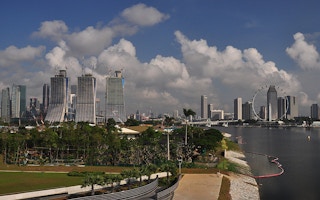In many Asian cities, including Singapore, the interest in sustainable living is growing as the effects of global warming—intense extreme weather events and rising sea levels—leave their mark across the region. Without radical change, Asia Pacific will account for 48 per cent of global carbon emissions by 2030.
The race to build green cities across Asia is on. An estimated US$6 billion is expected to go into financing projects to counter climate change by 2020, focusing on renewable energy, energy efficiency, sustainable transport, resilient infrastructure, and better preparation for climate-related disasters.
Singapore: A fast-growing green city
Green buildings, which have a lower carbon footprint compared to regular buildings, are key to sustainable urban planning since the built environment contributes 33 per cent of global greenhouse gas emissions.
It has been estimated that urban residents could save as much as US$16 billion annually through the use of intelligent, energy efficient technologies. To date, Singapore has “greened” more than a third of the building stock (by gross floor area). In fact, we rank second among global cities for green buildings, according to a 2016 report.
But to reach the government’s aim of having 80 per cent of Singapore’s buildings certified under the Building and Construction Authority Green Mark scheme by 2030, we need to green an additional 50 per cent of our buildings within the next 12 years.
More than 80 per cent of local organisations and 70 per cent of global organisations today than in 2016, according to the 2017 Johnson Controls Energy Efficiency Indicator survey, which polled more than 1,500 facility and management executives worldwide.
With 2018 designated as the Year of Climate Action for Singapore, close to a quarter of a million citizens, business corporations and civil have pledged to take climate action and reduce their carbon footprint. The nation has also committed under the Paris Agreement to reduce its greenhouse gas emissions intensity by 36 per cent compared to 2005 levels by 2030.
Are you focusing on energy efficiency?
Given the importance of energy efficiency in sustainable living, how are local companies addressing the issue?
Our survey findings revealed a strong positive outlook for green investments among local respondents. Eighty-three per cent of Singapore companies have said they are expecting to increase investments on energy efficiency projects, a strong lead over the global average of nearly 60 per cent.
Outfitting buildings to be more energy efficient is a key component of creating sustainable buildings. Some possible solutions include energy-efficient cooling devices and systems that streamline energy use. In fact, improvements to heating, ventilation, and air conditioning ranked as the top energy efficiency measure adopted by nearly 80 per cent of local companies in the survey.
Are you actively integrating your building systems?
Smart technologies are an integral part of green buildings. As built environments become greener and smarter, there will be more demand for agile products and systems that are smart, cyber-secure and future ready.
In the last year, about 43 per cent of local organisations have reported investing in systems integration. Heading the list is integration with external data sources, such as weather and utility information with other building technology systems, followed by integration with energy management, life safety systems, and lighting systems.
Smart buildings are responsive to the needs of the occupants in real time, leveraging building data to optimise energy usage, lower facility costs, reduce greenhouse gas emissions while ensuring safety and sustainability. These green buildings often connect internal systems—such as heating, ventilation, cooling, data networks, power management and surveillance—with external networks to manage building operations more efficiently.
Do you have net zero built environments in the pipeline?
Building net zero energy building and further reducing greenhouse gas footprint should also be on organisations’ radars as we move toward green, sustainable urban living.
The increase in local demand for green buildings is expected to pump up demand for net zero energy buildings as well, according to our survey. It showed that 66 per cent of organisations in Singapore are very likely to plan to achieve near zero, net zero or energy positive status for at least one building within the next 10 years. In comparison, about 54 per cent of organisations globally are committed to the same goal.
Effective carbon reduction in the built environment is a concerted effort that depends on a combination of planning, design, construction and use. New buildings offer the largest potential savings of 75 per cent or higher in energy use; although it would require an approach that combines technological and behavioural change. Building owners should thus consider energy savings from the beginning of the project as part of construction and design.
However, nearly 30 per cent of local companies lack the technical expertise to evaluate or execute projects as the primary barrier to pursuing energy efficiency. Other obstacles included the lack of funding to pay for improvements, as well as the uncertainty regarding savings and performance.
Green up to keep up
It will take active involvement, close cooperation and mindset change of organisations and communities to achieve environmental sustainability. Joining the growing ranks of organisations that have integrated myriad systems such as life safety, lighting, water management with advanced building technology would be a good start. Gaining insights and new ideas from regional collaborative platforms, such as the World Green Building Council, to jump-start your green building projects could be another.
Leveraging performance benchmarking and certifications can be effective in driving energy efficiency improvements. More than 80 per cent of local respondents ranked benchmarking and certification as very important. Other effective policies included government leadership in leasing, building design, and retrofits; as well as public and private sector building efficiency targets.
Experts have singled out a clearly defined governance structure and effective leadership as the bedrock to the success of any enterprise-wide strategy. Without exception, a successful climate change strategy necessitates a holistic approach that requires competence that cuts across functions, operations and geographies.
Ken Lim is General Manager and Managing Director, BT&S Singapore at Johnson Controls. This article was written for Eco-Business.


















